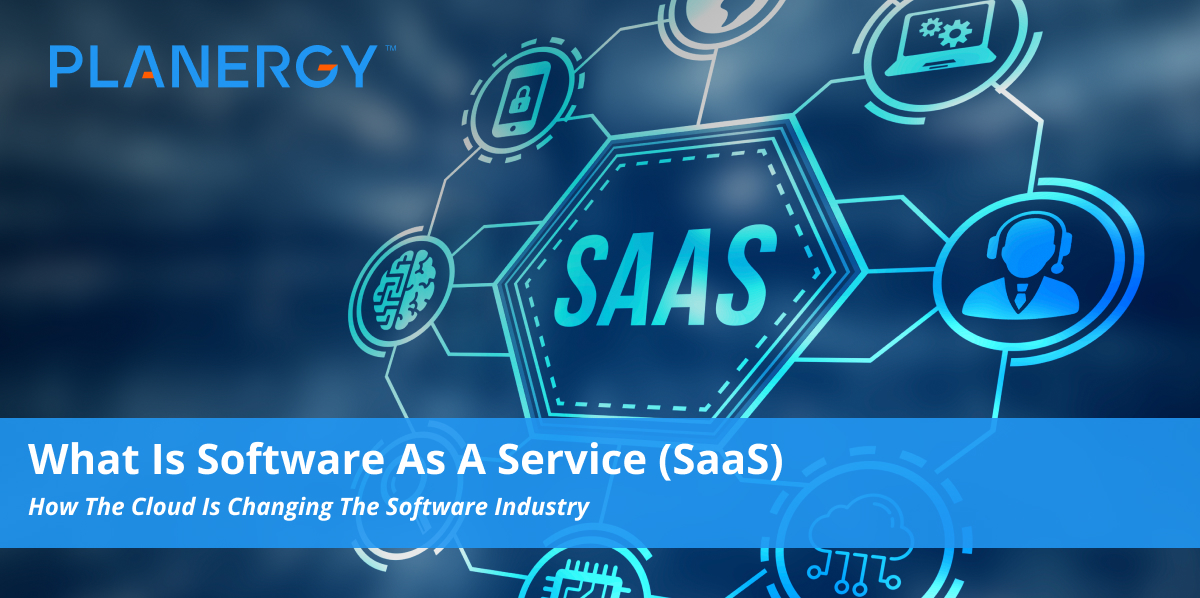The purpose of this post is to answer a question we get all the time – what is SaaS? We’ll define the meaning of SaaS and describe how it differs from on-premise solutions (also known as on-site), explain the key benefits, share some examples of leading SaaS companies for illustration, and explore some recent trends.
What Is Software as a Service?
TechTarget, a leading technology media company, defines Software as a Service (SaaS) as a “software distribution model in which a third-party provider hosts applications and makes them available to customers over the Internet.”
In laymen’s terms, SaaS businesses provide a software that can be accessed from any device with an internet connection through a pay-for-use or subscription model.
What Is On-Premise?
According to Techopedia, an online technology dictionary, defines on-premise solutions as “a type of software delivery model that is installed and operated from a customer’s in-house server and computing infrastructure. It utilizes an organization’s native computing resources and requires only a licensed or purchased copy of software from an independent software vendor.”
It’s important to mention that “on-premise” was originally known as “on-premises” because it is hosted at your own physical location. The industry has since shortened the term to “on-premise.” Examples of on-premise solutions are Sharepoint and the Adobe Creative Suite.
How Does SaaS Differ From On-Premise?
With SaaS solutions, you essentially rent software from the provider. They are responsible for upgrades, data storage, and security. With on-premise solutions (or “on-prem” if you’re a techie), you license a software and host it “on premise.”
This means that you are in charge of the hardware, support, and infrastructure on an ongoing basis.
SaaS is still a relatively new technology. As a result, its market share is still smaller than on-premise, but that is set to change based on steadily increasing demand for SaaS over and above on-premise solutions.
What Are Examples of Software as a Service Companies?
Here are a few examples of Software as a Service companies in no particular order. We’ve chosen these as examples for three key reasons:
1) They top many “best-of” lists; 2) You’ve probably heard their names before; and 3) They do very different things.
Salesforce.com
Salesforce.com is recognized by many as the founder of the SaaS industry. Salesforce.com is a public company based in San Francisco, CA that was founded in 1999.
Its CRM (customer relationship management) platform enables businesses to manage their customers and prospects in one central location. The company provides solutions to its 150,000 customers via the Cloud.
Athenahealth
Athenahealth provides technology services to medical professionals. Physicians use Athenahealth to manage billing and other operations-related health management services through the Cloud.
The public company was founded in 1997 and is headquartered in Watertown, MA. Athenahealth is leading the healthcare IT industry, which is poised to reach $280B in 2021, up from $134B in 2016.
Slack
Slack is the “current coolest SaaS on the block” according to SaaScribe. Slack is a cloud-based collaboration platform that allows teams to share messages and files real-time.
Slack is a private company that is valued at $3.8B, which is truly amazing considering it’s only four years old. Fun fact: Slack stands for “Searchable Log of All Conversation and Knowledge.”
DocuSign
DocuSign is an electronic signature technology that enables businesses to sign and exchange digital contracts. It was started in 2003 and is now headquartered in San Francisco (seeing a trend here?).
85 million users generate nearly 950,000 transactions per day. This SaaS solution has completely modernized the back-and-forth of contractual agreements.
SurveyMonkey
Is it possible to dislike this company’s name? We think not. Founded in 1999, SurveyMonkey is an online survey development company that allows businesses to collect and analyze data.
The company’s simple user interface has made collecting market research and customer feedback easier than ever. SurveyMonkey was #6 on the Forbes Cloud 100 list in 2016.
One interesting thing to point out is that all of these businesses have been founded in the last twenty years, which is around when Software as a Service really started to take off.
It’s no wonder these tech giants are at the leading edge of the SaaS market considering their uncanny ability to innovate and to leverage the major benefits of SaaS over other solutions.
Benefits of SaaS Solutions
The global Software as a Service market is forecasted to expand to $50.8B by 2018, which represents a 16.7% increase from $22.6B in 2013. Here are the key reasons why businesses are adopting SaaS solutions and driving exponential growth in the SaaS market:
Lower Costs
SaaS solutions require an ongoing subscription fee instead of paying for an all-in hardware license up front. There is a lower cost of entry since you’re not using internal resources for initial installation and integration.
Easy Upgrades
The SaaS provider is in charge of all upgrades, so there are no clunky patches for IT teams to install. This means that updates happen on the go, so you’re always working with the most updated version of the software. Bugs, be gone!
High Adoption Rates
The learning curve for SaaS solutions is low given that users can access them using familiar web browsers. In SaaS, you often hear the phrase, “login and play around,” because they’re far easier to navigate and get to know than on-premise alternatives.
Seamless Integrations
SaaS solutions are specifically designed to integrate seamlessly with other business solutions. These integrations happen through APIs (application programming interfaces), which allow programs to communicate with each other easily and use each other’s functions.
Better Scalability
If business is booming and you’ve just hired an additional 100 employees, there is no need to buy more servers and bog down your IT staff with installations on new computers. Just adjust your subscription to the next level.
More Flexibility
SaaS solutions are internet-based, so you can access them from any device that has internet access (e.g. smart phone, tablet, or laptop).
Consider how beneficial this is for those who travel often, or for those who like to get work done at home in off-hours.
Faster Impact
Implementations can happen in record time for SaaS solutions. Most SaaS solutions are not custom-built (although customizations are often possible). Instead, they are tested and proven by many other users. The kinks are already worked out instead of placing that burden on your employees, decreasing the time to realize the benefits.
More Accessibility
SaaS solutions have been hugely beneficial for small and medium businesses (SMBs). Traditionally, high license fees have prevented SMBs from utilizing technologies that can take their business to the next level. SaaS solutions like Mailchimp (an easy-to-use email marketing platform) and Shopify (an online shopping cart for e-commerce businesses) have been game-changers for SMBs.
Many of these benefits have bottom-line impact, so it’s not surprising that SaaS is taking off like it is. It’s just as popular with users as it is IT teams that appreciate the low costs, easy integrations, and greater flexibility.
Trends in the SaaS Industry
There is no doubt that Software as a Service is completely changing the technology world – and the corporate world, for that matter. Here are three recent trends in SaaS that you should know:
Data Security Reigns
Maintaining data security with the rise in the IoT and BYOD (Bring Your Own Device) market will be difficult, to say the least.
An increasing number of devices (smartphones, tablets, etc.) are accessing personal and/or confidential information, so controlling security whilst maintaining flexibility will be a top concern for SaaS providers.
Integration, integration, integration
The beauty of SaaS is that you can pick and choose the solutions you need to run your business most effectively – there is no cookie-cutter approach you must take.
The flipside of this advantage is that many users utilize multiple SaaS solutions on a daily basis. With that in mind, providers that can integrate easily will naturally rise to the top.
Customer First
The quick rise of the SaaS world means an innovative and highly competitive market. This also means that customer retention has become a focus for veteran providers.
The 2016 SaaS Metrics Report by Totango found that approximately half of SaaS companies increased spend on customer retention from 2015-2016. Customer focus is always a good practice, so if you ask us, this trend is here to stay.
Bringing SaaS Home to the Procurement Industry
According to Forrester, SaaS adoption to date has been focused on four segments: human resource management (HRM), customer relationship management (CRM), collaboration software (e.g., email), and procurement solutions. In procurement particularly, SaaS has helped to make the entire process more efficient.
Payments are made faster and easier due to streamlined communications. On top of that, procurement has more visibility into company spend, resulting in better control and smarter, more informed decisions. With live budget views, procurement can see exactly what’s left in the budget before expenses are approved.
Another huge benefit to a SaaS solution for procurement is the ability to get work done on the go and keep the approvals process moving along. Secure, cloud-based procurement systems like PLANERGY can be accessed from your computer, smartphone, or tablet.
With e-mail and mobile approvals, procurement can approve or reject purchases in a meeting, at their desk, or while they’re traveling, and purchasers are notified automatically. Orders can be processed quickly and easily.
We hope this post has given you an understanding of what Software as a Service is, how it’s different from traditional solutions, and why it’s beneficial for businesses, particularly those needing help improving their procurement processes.




